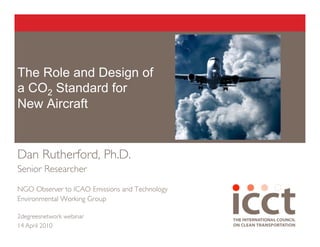
CO2 standard for new aircraft
- 1. The Role and Design of a CO2 Standard for New Aircraft Dan Rutherford, Ph.D. Senior Researcher NGO Observer to ICAO Emissions and Technology Environmental Working Group 2degreesnetwork webinar 14 April 2010
- 2. Overview Overview of the climate challenge Introduction to an aircraft CO2 standard – Recent policy developments – Why an aircraft standard? – Key design criteria What can’t a standard do? Conclusions
- 3. Business As Usual: 4X CO2 by 2050 ICAO 2050 projection (CAEP/8 forthcoming) Mt CO2/yr Source: IPCC Working Group III 4th Assessment Report, 2007. In total, 3.5~5.0% of global RF in 2005, counting NOx and cirrus impacts (Lee 2009)
- 4. Aviation CO2 missing from international climate agreements Kyoto protocol coverage of global aviation CO2 emissions assuming no post-2004 growth 700 600 CO2 emissions covered (MMT) 500 400 300 200 100 0 Worldwide total Kyoto now Source: ICCT, from data in SAGE Version 1.5 Global Aviation Emissions Inventories for 2000 through 2004.
- 5. What is the international community doing? ICAO High Level Declaration (10/2009) – 2% fuel efficiency improvement target to 2020 – 2% “aspirational goal” 2020~2050 – Development of a CO2 standard for new aircraft “types” UNFCCC/COP-15 (12/2009) – Ultimately silent on the issue of “bunkers” – Much interest in marine and aviation as source of adaptation funding CAEP/8 (2/2010) – Reaffirmed intent to set CO2 standard for new aircraft – Work may be completed 2013 with possible interim deliverables
- 6. Why an aircraft CO2 standard? Traditional industry position: Aviation is fuel price sensitive --> sufficient driver for efficiency already Evidence suggests room for improvement: – Efficiency gains from new equipment declined markedly after 1990, approximately flat since 2000 – Large jet manufacturers slow to develop new single-aisle aircraft – Race for speed and range impose efficiency penalty – Under-optimization of aircraft to allow for general use (stage length, belly freight capacity) An aircraft CO2 standard, properly designed, can: – Provide an incentive to deploy new technologies – Minimize emissions vs. performance tradeoffs – Promote increased optimization of aircraft to mission – “Force” technology???
- 7. New aircraft efficiency flat today
- 8. Lack of new designs driving stagnation Average Age of Aircraft Manufacturer Production Lines, 1960-2008 25 100 20 80 Seat-km Fuel Burn (1960=100) Age of Production Line (yr) Engine family 15 60 10 40 Aircraft series 5 20 0 0 1960 1965 1970 1975 1980 1985 1990 1995 2000 2005 Year ICCT (2009). “Efficiency Trends for New Commercial Jet Aircraft, 1960 to 2008.”
- 9. Emissions and performance tradeoffs exist Two flight options, San Francisco to Italy 907 kg CO2 517 kg CO2 62 kg 277 kg CO2 CO2 Estimated CO2 emissions (one-way) Ave EIS:1993 SFO-ZRH-FLR (6100 miles): 969 kg CO2 18% reduction Ave EIS:1985 SFO-JFK-PSA (6700 miles): 794 kg CO2 ICCT analysis, kayak.com and Piano-X model
- 10. Standard design issues Metrics: How to measure/compare aircraft efficiency? Applicability: cover all new aircraft or just new designs? Thresholds: need to cover turboprops, BJs? Certification procedure: what is an aviation “duty cycle” Stringency: How strict? Compliance: – Pass/fail at the aircraft level? – Averaging within an aircraft family? – Corporate averaging? Criteria for cost/cost effectiveness
- 11. Certification test points matter Relative block CO2 reductions at various operating points for an historical narrowbody replacement ICCT analysis using Piano-X model
- 12. Alternative compliance mechanisms important for an aircraft CO2 standard Efficiency standards enforced on a “pass/fail” basis tend not to raise fleetwide efficiency – “Pass/fail” used to regulate vehicle emissions, but rarely efficiency, and only in developing markets with large gap between best and worst – Sets up high stakes game where viability of particular models and even manufacturers is on the line – Favors “bottom scraper” rather than “top runner” standards Need to think flexibly about alternatives to traditional certification – Averaging within an aircraft family (commonality issue) – Corporate average: set a single target for a manufacturer --> let comply through means of their choice – “Soft” (e.g. financial, etc.) penalties for non-compliance? – Labeling – Other ideas?
- 13. What can’t an aircraft CO2 standard do? A standard cannot: – Put a general price on aviation carbon – Improve the efficiency of in-service aircraft – Promote operational improvements in fuel burn (ATM, CDAs, etc.) – Address NOx, AIC impacts Aircraft standard is only one part of a comprehensive climate strategy for aviation – Market-based measures – Incentives for operational improvements – Measures to address non-CO2 impacts of aviation – Others?
- 14. Non-CO2 climate impact may be the low hanging fruit Normalized operating costs vs. normalized 100 yr global warming impact for various designs of a narrowbody aircraft Schwartz, E. and Kroo, I.M. Aircraft Design: Trading Cost and Climate Impact. AIAA 2009-1261.
- 15. Conclusions Aviation climate challenge is a massive one that requires new thinking ICAO work on aircraft CO2 standard underway Potentially, standards can: – Speed technology deployment – Manage emissions vs. performance tradeoffs – Promote better optimization of aircraft to mission Standard one part of a comprehensive strategy – MBMs to price carbon – Measures to improve operational efficiency – Action on non-CO2 climate effects
- 16. Acknowledgements ClimateWorks and Hewlett Foundations Mazyar Zeinali, Fanta Kamakate, and Drew Kodjak (ICCT) CAEP WG3 colleagues
